|
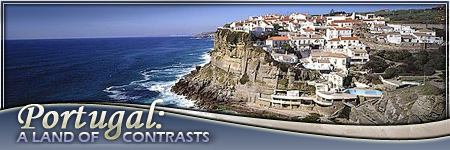
One of Europe's oldest countries, Portugal, delights with ancient castles, palaces and deep-rooted tradition
by
Tom Wuckovich
I was slow to leave Portugal. This reluctance consumed me virtually the moment I arrived in Lisbon with two other notable writers, all of us bent on discovering the history, tradition and culture of one of Europe’s oldest countries.
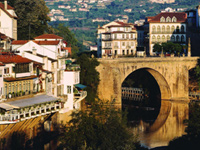 |
Armarante, Portugal Landscape |
Time was our only foe, with just a week to accomplish this formidable task. Despite an overnight flight and very little sleep, we declined to rest, opting instead to explore this pulsating city at the first oppor-tunity. After leaving our luggage at the Dom Pedro Hotel, situated in the heart of Lisbon’s business district, we set off on a guided stroll along wide esplanades paved with black and white mosaics, open squares where you can buy freshly roasted chestnuts in paper cones, mazes of cobbled alleys, and steeply winding streets where you must deftly avoid the quaint trams that whir by.
Lisbon’s downtown, the Baixa, was completely rebuilt after the devastating earthquake and resulting fires of 1755. The reconstructed buildings resemble a wood cage, which was deemed necessary for support in the event there were more seismic activities. The Baixa was considered one of the most modern models in Europe. The architect of this advanced design was the Marquês de Pombal, King Joseph the 1 sts prime minister. His imposing statue resides in the middle of the roundabout near the city center.
Lisbon also is known as the City of Seven Hills, and from St. George’s Castle atop one of the hills, you have a commanding view of the city’s terra-cotta tiled rooftops, ancient monuments, statues, the old quarters of the Barrio Alto and Alfama (where nostalgic fado is played nightly), and the Tagus River flowing under its lengthy but graceful suspension bridge. Down by the Tagus, from where many Portuguese explorers set sail, stands the Belém Tower with its fairytale turrets and the imposing Monument to the Discoveries. This beautiful carving, cast in 1960, commemorates the 500 th anniversary of the death of Prince Henry the Navigator, the central character in the Discoveries initiative. From the beach in Belém, Vasco da Gama set sail to discover the sea route to India. Also nearby is Jerónimo’s Monastery, a 16th-century building that is related to the Discoveries period and is designated as a UNESCO World Heritage site. There are many such historic sites and neighborhoods within the city, and they create a passion for the streets. Walking is by far the most popular way to tour the city, but there are guided bus tours, and a tram is another alternative. The No. 28 tram follows a route along Lisbon’s hills, beginning its journey at the Prazeres Cemetery.
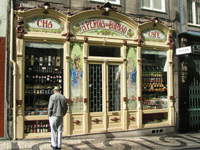 |
City Shopping in Lisbon, Portugal |
Streets that should be trod include the Rua Augusta, the main artery of the Baixa, the city’s traditional shopping district, and the Avenida da Liberdade, home to exclusive international boutiques and shops. It was the favorite promenade for the Lisbon elite in the 19th century. The pavements in this city are regarded as works of art, and the calcada portuguesa is the traditional black and white stone mosaic embedded in most of the streets.
The Parque das Nacoes—the riverside venue for Expo 98 World Exhibition in the east side of Lisbon—transformed this former industrial area into a cultural, entertainment and residential center and draws visitors and locals for concerts, sports events and to play in the new Casino de Lisboa. Opt for a ride on the cable car here that offers breathtaking views of the river and the city along its one-mile circuit.
Nighttime is the right time for Lisbon. There is always something happening, whether it’s a cultural event, fiesta, fair or festival. You won’t be able to do all there is to do, so target areas such as the Bairro Alto, which has a unique tradition in the history of Lisbon nightlife. It’s the part of the city with the most bars, and every evening—but especially Fridays and Saturdays—the narrow cobblestone streets are jammed with people, young and old alike. The vibe of the Bairro spreads to nearby neighborhoods such as Bica and Principe Real.
Along the riverside in the Docas, in Alcantara and Santo Amaro, you will find a plethora of lively happenings. The most well-known clubs are here, along with dance venues and excellent restaurants. There are also occasional concerts to entertain, and you can’t top the location right along the river.
While Lisbon could command all your attention, it is a good place from which to explore other regions within driving distance. The Algarve region in the south of Portugal is where the locals vacation. The golden beaches and warm waters give the Algarve more of a Mediterranean feel than an Atlantic flavor. Golf, tennis and watersports, along with glittering casinos and clubs, are a big draw. We were temped by this area, but decided to go north and visit more traditional, historic enclaves such as Sintra, Obidos, Porto and the Douro wine vineyards.
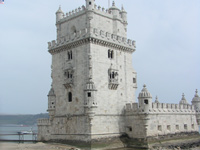 |
One of Portugal's Many Castles |
We were told that Sintra is a place “you have to feel,” not just see. Once immersed in the dense colors of its landscape, the mystery surrounding Serra or Monte da Lua (Mount of the Moon), and its ancestral legends and traditions, we found it easy to immerse ourselves into this spiritual environment. The Monte da Lua spawned a number of astral cults whose influence is still visible in the monuments and archaeological objects that span many eras. There are magnificent sites to explore, not the least of which is Cabo da Roca, the westernmost point of the European continent. This outcrop of rocky coastline on the Atlantic Ocean is the end point of the Serra de Sintra, a range of mountains winding down to the ocean to form the Cabo da Roca. Visitors receive a signed and sealed certificate noting their visit to this European landmark.
Sintra still retains its medieval character, punctuated by narrow, labyrinth-type streets, steps and arcades. There is a National Palace, built over time, a Clock Tower, the Santa Martinho Church, and an impressive group of ancestral fountains as well as the Jewish Quarter. A horse-drawn carriage ride through the town is the most prudent way to see the highlights.
And speaking of high, just above the town is the quirky and colorful Pena Palace, built on the site of the ruins of an old monastery. The palace was constructed in two stages, first in 1849 and then be-tween 1868 and 1885. It appears to have no cohesive design, with different portions placed together as if by chance. There is no "style," but that is what makes it so unusual and attractive. Most noteworthy are the quarters of King Carlos and Queen Amelia, the last royal couple to live in the palace, as well as the panoramic views of the surrounding landscape from the palace walls.
There seem to be castles and palaces everywhere in Portugal, and we found more in Obidos, a village known as the "Town of the Queens," due to the royal tradition of the king giving the town to his queen as a wedding present. Enchanting, quaint and charming, the town is completely surrounded by walls dating back to the Moorish occupation. The town was recaptured by King Afonso Henriques in 1148, and the castle has been converted into a small hotel, or pousada. Obidos has many churches and chapels filled with works of art, tiles, paintings, woodcarving and religious vestments. Along its streets and alleyways there are shops, restaurants and an occasional tavern where you can take a brief respite from walking and sample Obidos’ most important product—Ginja. Ginja is a sweel local wine comprised of sour cherries, honey and sugar. It’s a potent beverage, and the Bar Ibn Errik Rex claims to have the best concoction. No argument here.
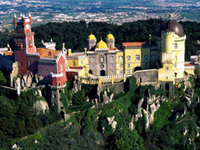 |
Quirky and Colorful Pena Palace |
After Obidos, it was time to leave for Porto, in the heart of Portugal’s wine country, where, along the Douro River, vineyards planted in steps carved into the mountainsides go on for as far as the eye can see. Port wines are one of the oldest and most appreciated wines in the world, as a visit to Sandeman Wine Cellar and Museum reveals. But there’s more to Porto than wine. The city’s historic center includes such lively sites as the Casa da Musica, a striking auditorium and performance arena with a rooftop café and stellar lineup of events; a contemporary art museum set in Porto’s Parque Serralves that houses a permanent collection and rotating exhibits; the ancient São Bento Train Station; and the inimitable Café Majestic, a richly textured, intimate café with walls of dark mahogany that is remini-scent of those establishments appearing in movies related to World War II, where numerous mysterious encounters were the norm.
On our last day, a rich, tempting blend of strong coffee in a demitasse was the fitting end to a flawless trip to one of Europe’s most intriguing countries.
|